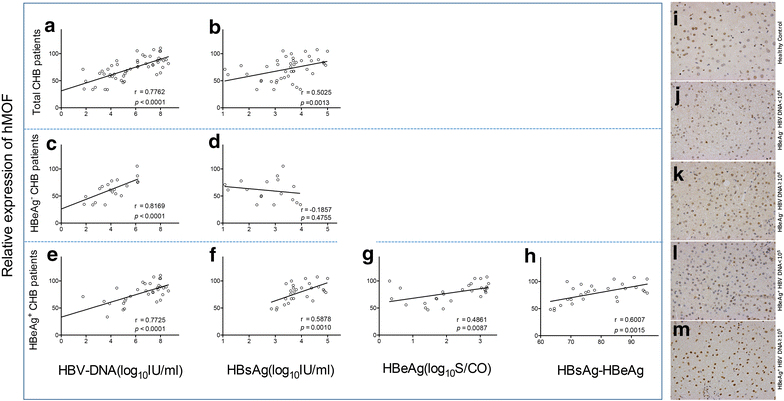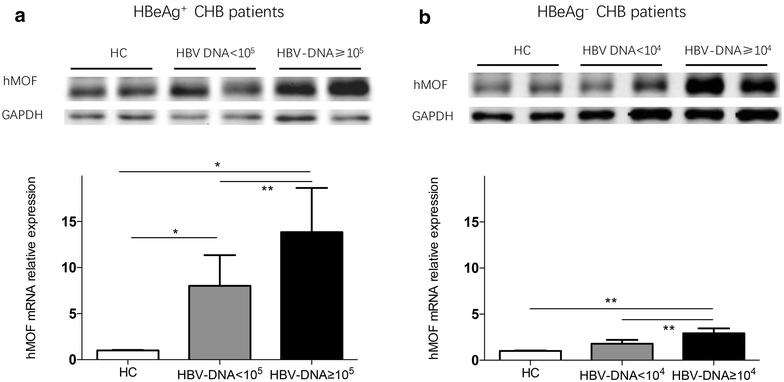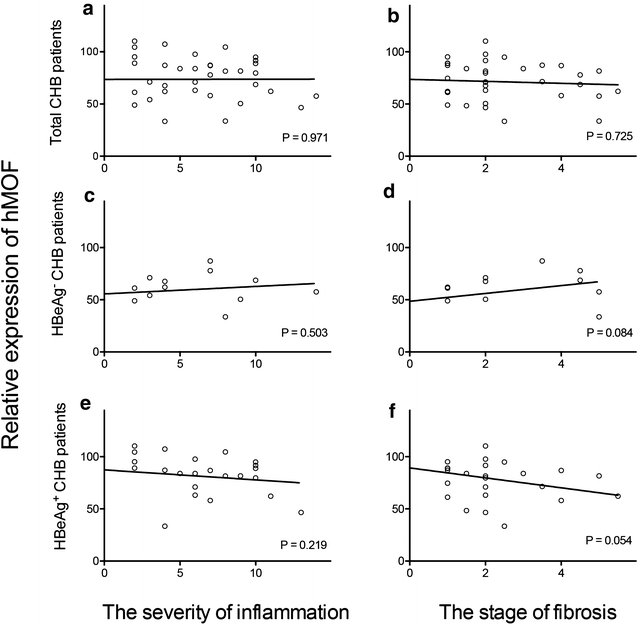Correlation between hepatic human males absent on the first (hMOF) and viral persistence in chronic hepatitis B patients
- PMID: 29484170
- PMCID: PMC5819663
- DOI: 10.1186/s13578-018-0215-5
Correlation between hepatic human males absent on the first (hMOF) and viral persistence in chronic hepatitis B patients
Abstract
Background: Chronic hepatitis B (CHB) remains a global health dilemma with high morbidity and mortality. Human males absent on the first (hMOF) (a histone acetyltransferase) is responsible for DNA damage repair, tumorigenesis and cell cycle regulation. Persistence of HBV DNA contributes to cirrhosis and hepatocellular carcinoma (HCC) in CHB patients. Histone acetyltransferase enhances HBV replication, however the precise underlying mechanism of hMOF in HBV replication in CHB patients remains to be explored. This study aims to investigate the correlation between hepatic hMOF and HBV DNA replication in CHB patients, and may provide new insights towards the treatment of CHB patients.
Methods: hMOF in liver biopsy (CHB, n = 33 HBeAg+; n = 20 HBeAg-, and three healthy controls) was determined, using immunohistochemistry, qPCR and Western blot. The correlation between hMOF and HBsAg, as well as, HBeAg were determined.
Results: A positive correlation between hMOF and HBV DNA in overall CHB patients was observed. A distinct positive correlation between hMOF and HBsAg and/or HBeAg in HBeAg+ CHB patients was also detected, however not observed between hMOF and HBsAg in HBeAg- CHB patients. No correlation was observed between hMOF and hepatic inflammation severity and fibrotic stage in CHB patients.
Conclusions: Hepatic hMOF might contribute to host HBV clearance in CHB patients and possible pathogenesis.
Keywords: Chronicity; Epigenetic regulation; Hepatitis B; Viral replication; hMOF.
Figures



Similar articles
-
Serum hepatitis B surface antigen and hepatitis B e antigen titers: disease phase influences correlation with viral load and intrahepatic hepatitis B virus markers.Hepatology. 2010 Jun;51(6):1933-44. doi: 10.1002/hep.23571. Hepatology. 2010. PMID: 20512987
-
Analysis of intrahepatic total HBV DNA, cccDNA and serum HBsAg level in Chronic Hepatitis B patients with undetectable serum HBV DNA during oral antiviral therapy.Clin Res Hepatol Gastroenterol. 2017 Dec;41(6):635-643. doi: 10.1016/j.clinre.2017.03.004. Epub 2017 Apr 21. Clin Res Hepatol Gastroenterol. 2017. PMID: 28438570
-
[Relationship between hepatitis B surface antigen, HBV DNA quantity and liver fibrosis severity].Zhonghua Gan Zang Bing Za Zhi. 2015 Apr;23(4):254-7. doi: 10.3760/cma.j.issn.1007-3418.2015.04.005. Zhonghua Gan Zang Bing Za Zhi. 2015. PMID: 26133815 Chinese.
-
Chronic hepatitis B virus infection in Asian countries.J Gastroenterol Hepatol. 2000 Dec;15(12):1356-61. doi: 10.1046/j.1440-1746.2000.0150121356.x. J Gastroenterol Hepatol. 2000. PMID: 11197043 Review.
-
Treatment of chronic hepatitis B: case selection and duration of therapy.J Gastroenterol Hepatol. 2002 Apr;17(4):409-14. doi: 10.1046/j.1440-1746.2002.02767.x. J Gastroenterol Hepatol. 2002. PMID: 11982721 Review.
Cited by
-
Interleukin-38 in colorectal cancer: a potential role in precision medicine.Cancer Immunol Immunother. 2020 Jan;69(1):69-79. doi: 10.1007/s00262-019-02440-7. Epub 2019 Nov 30. Cancer Immunol Immunother. 2020. PMID: 31786620 Free PMC article.
-
Control of the Germinal Center by Follicular Regulatory T Cells During Infection.Front Immunol. 2018 Nov 20;9:2704. doi: 10.3389/fimmu.2018.02704. eCollection 2018. Front Immunol. 2018. PMID: 30524440 Free PMC article. Review.
-
Exploring the clinical significance of IL-38 correlation with PD-1, CTLA-4, and FOXP3 in colorectal cancer draining lymph nodes.Front Immunol. 2024 Mar 12;15:1384548. doi: 10.3389/fimmu.2024.1384548. eCollection 2024. Front Immunol. 2024. PMID: 38533512 Free PMC article.
References
LinkOut - more resources
Full Text Sources
Other Literature Sources

